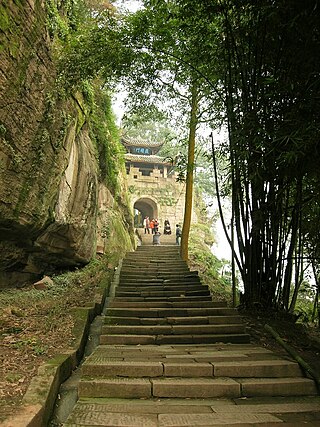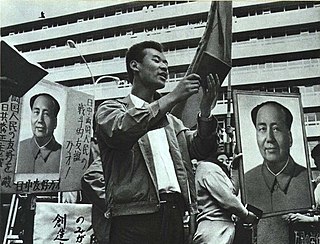The following units and commanders fought in the Battle of Changde in early November through late December 1943, part of the Second Sino-Japanese War .
The following units and commanders fought in the Battle of Changde in early November through late December 1943, part of the Second Sino-Japanese War .
From end of October 1943. [1] [2]
Eleventh Army
Lieut. General Isamu Yokoyama
|
|
|
As of end of October 1943. [1]
National Military Council
|
|
The Battle of West Henan–North Hubei was one of the 22 major engagements between the National Revolutionary Army and Imperial Japanese Army during the Second Sino-Japanese War. It was fought in March–May 1945 in northern Hubei and western Henan. While it was a tactical stalemate, the battle was an operational victory for the Japanese forces, who seized control of local airbases, denying Chinese forces any localized air support.
Battle of Yunnan-Burma Road was the name of the Chinese intervention to aid their British allies in the 1942 Burma Campaign. Its forces were composed of the Fifth, Sixth and Sixty-sixth Army under the command of the Chinese Expeditionary Force in Burma, commanded by Lt. General Joseph Stilwell, Lt. General Luo Zhuoying was his executive officer.
The order of battle for the Battle of South Guangxi by country is as follows:
Below is the order of battle for the Battle of Beiping-Tianjin, called the Peiking-Tientsin Operation in pinyin spelling, a series of battles fought from 25 July through 31 July 1937 as part of the Second Sino-Japanese War. It was called the North China Incident by the Japanese.
Below is the order of battle for the Amoy Operation fought May 10–12, 1938, part of a campaign by the Imperial Japanese Navy to blockade the Republic of China during the Second Sino-Japanese War.
The following units and commanders fought in the Battle of Lanfeng in May 1938.
This is the Battle of Pingxingguan order of battle during the Second Sino-Japanese War.
Men Bingyue was a general in the Chinese National Revolutionary Army during the Second Sino-Japanese War. As commander of the 7th Cavalry Division he participated in the Suiyuan Campaign in 1936, defeating the Japanese backed Inner Mongolian Army. After the beginning of the Second Sino-Japanese War in 1937 he was made Commander of the 6th Cavalry Army, fighting in the Battle of Taiyuan defending Suiyuan. In 1940 he was made Deputy Commander in Chief of the 17th Army Group. In 1941, he was made Commander of the 7th Cavalry Army. He died in August 1944 in Chongqing.
Hundred Regiments Offensive
Below is the order of battle for the Western Henan - Northern Hubei Border Campaign, fought late March through late May 1945. It was one of the 22 major engagements between the National Revolutionary Army and the Imperial Japanese Army during the Second Sino-Japanese War.

The Hundred Regiments Offensive also known as the Hundred Regiments Campaign was a major campaign of the Chinese Communist Party's National Revolutionary Army divisions. It was commanded by Peng Dehuai against the Imperial Japanese Army in Central China. The battle had long been the focus of propaganda in the history of Chinese Communist Party but had become Peng Dehuai's "crime" during the Cultural Revolution. Certain issues regarding its launching and consequences are still controversial.
Order of Liberation was a Chinese military award awarded to heroes of the Liberation of mainland China during the Second Chinese Civil War between 3 September 1945 and 30 June 1950. There are three grades: First Class Medal, Second Class Medal, and Third Class Medal.
The August 1 Medal, sometimes known as the Order of Bayi, was a Chinese military award awarded to heroes of the Liberation of China during the Chinese Civil War, that started on August 1, 1927. There are three grades: First Class, Second Class, and Third Class.
Dissent in the Armed Forces of the Empire of Japan refers to serious cases of military insubordination within the institution, from the founding of the Empire of Japan in 1868 to its defeat during World War II in 1945.

Counter-Japanese Military and Political University, also commonly known as Kàngdà (抗大) and Kangri Junzheng University (抗日军政大学), was a comprehensive public university located in Yan'an, Shaanxi, the headquarters of the Chinese Communist Party during the Second Sino-Japanese War. Its former site has been converted to a memorial hall.
Fang Quan, courtesy name Peiqing (培卿), was a late Qing Empire Mandarin, scholar, author and educator.
Liu Zhonghua was a Chinese military officer. He was commander and political commissar of the PLA Navy 6th Fleet in 1953, and president of Naval Senior Institute in 1957. In 1955 he was awarded the rank of major general (shaojiang).

The Sichuan anti-Mongol fortresses are 83 mountain cities built by the soldiers and civilians of the Southern Song Dynasty during the Mongol conquest of China in Sichuan to resist the invasion of the Mongol Empire. Taking full advantage of the geographical advantages of the Sichuan Basin, these fortresses formed a comprehensive three-dimensional defense system, which succeeded in resisting the Mongol attacks for up to 53 years, greatly extending the life of Southern Song. They also made Sichuan the last to be conquered by the Mongolians in 1288. Due to the defense of the fortresses, it was difficult to settle the Sichuan region. The Mongol Army had to abort its original strategy of "taking Shu (Sichuan) and destroying Song" and moved to the area of Jingzhou and Xiangyang starting from 1271, defeating the Song Dynasty via the Han River. Möngke Khan became the only Mongol khagan to perish on the battlefield when he died during an assault on Diaoyucheng in 1259. He may have been a victim of dysentery or of injuries sustained when attacking the fortress.

Mao Zedong, the longtime Chairman of the Chinese Communist Party and the founder of the People's Republic of China, was reported to have expressed his gratitude to the Japanese military and political figures who visited China in the 1950s and 1970s. Mao said that the Japanese invasion of China had united Chinese people and allowed the Chinese Communist Party to win the Chinese Civil War. In the 21st century, these remarks by Mao caused strong reactions on the internet in China. With the 2020 Hong Kong Diploma of Secondary Education Examination (HKDSE) history subject controversy on the historical understanding of Japan's invasion of China, these remarks have returned to the spotlight on Hong Kong and mainland Chinese websites. The word "thanks" expressed by Mao has been also interpreted by some observers as dark humour.